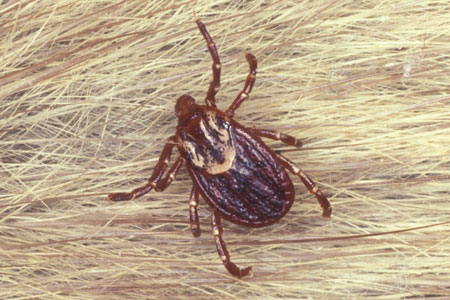Active Seasons




American Dog Ticks Appearance and Size Facts
The American dog tick gets its name from its preference to feed off domestic dogs. This makes these pesky critters more than a common nuisance for Florida homeowners. But with the right tools and information, you can lean on our team at Hulett Environmental Services to help detect and remove any potential, current, or future American dog tick infestations. Let’s begin with identifying a few common traits of American dog ticks:
- Size. They usually measure 3/16 of an inch and a little over half an inch when engorged.
- Color. They’re brown with gray to white markings.
- Body. These ticks have oval-shaped and flattened bodies.
- Region. They can be found across the United States except in the Rocky Mountains region.
Distinguishing American Dog Ticks From Other Ticks
Unlike some ticks found throughout Florida, American dog ticks belong to the hard tick family and have a hard exterior shell. While they’re known for their ability to bite and transmit diseases, they’re also known to prefer domestic dogs as hosts over humans. However, these differences can be hard to detect with an untrained eye. For the most accurate tick identification, turn to professional pest control for help.
We provide services for American dog ticks in the following locations and their surrounding areas:

Behavior and Habitat of American Dog Ticks
American dog ticks tend to hide in low vegetation where mammals pass by. From there, they can attach to a host and find their way inside. Although they prefer domestic dogs, they also feed off humans, which can lead to the transmission of disease. Once ready to lay eggs, females detach themselves from their host and search for a suitable location to lay their eggs. They lay their eggs over a period of 14 to 32 days and can lay up to 6,500 eggs, which hatch in about 36 to 57 days.

Signs of Infestation of American Dog Ticks
Tall grass and shrubbery is a common hiding place for American dog ticks and can easily attract an infestation into your home. Sightings in your yard or on your pet are also common signs of an infestation. Another common sign of an infestation is the presence of eggs near gardens and potted plants, as these are common areas for females after detaching from their host. If you see any of these signs in your Florida home, take action now.

Tips for Prevention of American Dog Ticks
To help prevent an infestation from taking over your Florida home or yard, make sure your grass is frequently cut and pets are well trimmed. Also, consider wearing long-sleeved shirts and clothing to better protect your body from bites. If you think ticks are on your clothing, wash them immediately.
Getting Rid of American Dog Ticks
If you try to combat an infestation alone, you’ll find that not even home remedies will give you the results you need. This is why when you need effective tick and general pest removal, it’s important to turn to the pros. With the best professional pest control services, like those offered by Hulett, you can gain protection for not only your residential space but your commercial space as well.
Effective American Dog Tick Control
Why let your American dog tick infestation grow and bother you and your pets further? For the best tick control services in Florida, just call Hulett! Our team of top-notch pest technicians applies green and pet-friendly treatments to remove and prevent pests from coming back into your home or office. Get started today and schedule your free inspection online!

